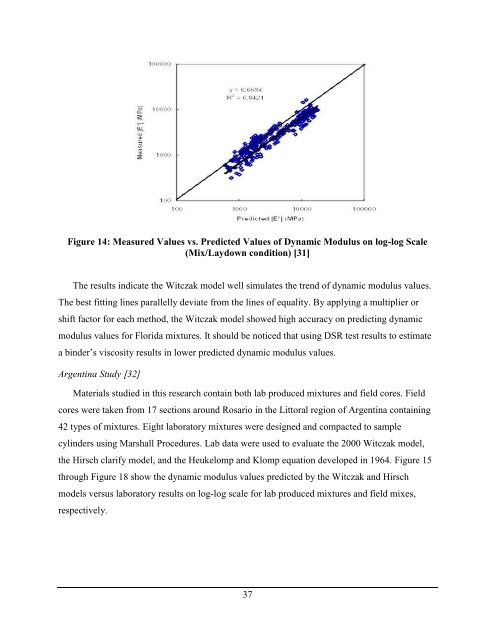Modification of Dynamic Modulus Predictive Models for Asphalt ...
Modification of Dynamic Modulus Predictive Models for Asphalt ...
Modification of Dynamic Modulus Predictive Models for Asphalt ...
Create successful ePaper yourself
Turn your PDF publications into a flip-book with our unique Google optimized e-Paper software.
Figure 14: Measured Values vs. Predicted Values <strong>of</strong> <strong>Dynamic</strong> <strong>Modulus</strong> on log-log Scale<br />
(Mix/Laydown condition) [31]<br />
The results indicate the Witczak model well simulates the trend <strong>of</strong> dynamic modulus values.<br />
The best fitting lines parallelly deviate from the lines <strong>of</strong> equality. By applying a multiplier or<br />
shift factor <strong>for</strong> each method, the Witczak model showed high accuracy on predicting dynamic<br />
modulus values <strong>for</strong> Florida mixtures. It should be noticed that using DSR test results to estimate<br />
a binder’s viscosity results in lower predicted dynamic modulus values.<br />
Argentina Study [32]<br />
Materials studied in this research contain both lab produced mixtures and field cores. Field<br />
cores were taken from 17 sections around Rosario in the Littoral region <strong>of</strong> Argentina containing<br />
42 types <strong>of</strong> mixtures. Eight laboratory mixtures were designed and compacted to sample<br />
cylinders using Marshall Procedures. Lab data were used to evaluate the 2000 Witczak model,<br />
the Hirsch clarify model, and the Heukelomp and Klomp equation developed in 1964. Figure 15<br />
through Figure 18 show the dynamic modulus values predicted by the Witczak and Hirsch<br />
models versus laboratory results on log-log scale <strong>for</strong> lab produced mixtures and field mixes,<br />
respectively.<br />
37
















